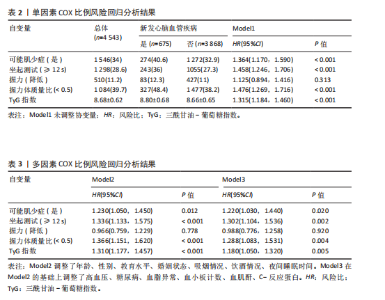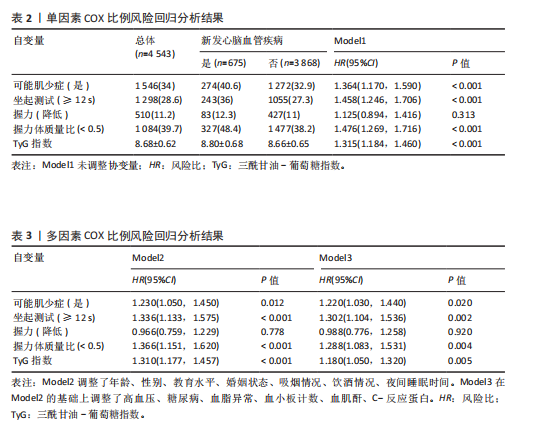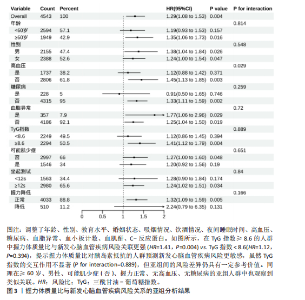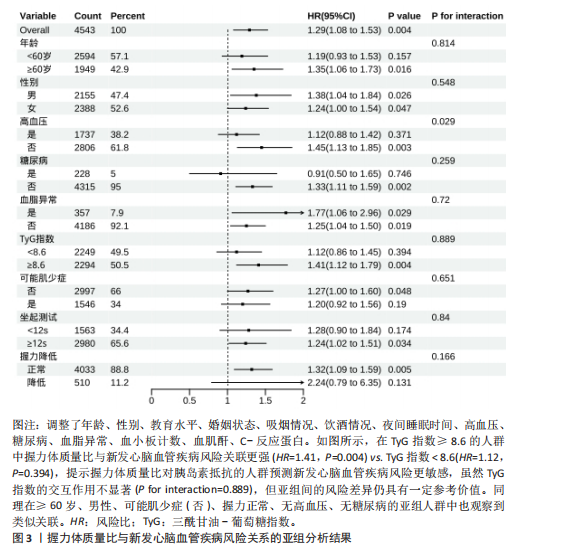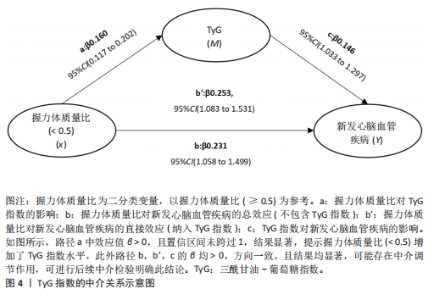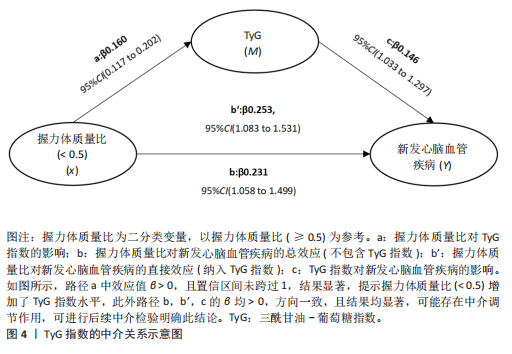Chinese Journal of Tissue Engineering Research ›› 2026, Vol. 30 ›› Issue (12): 3190-3197.doi: 10.12307/2026.629
Previous Articles Next Articles
Association between grip strength to weight ratio and new-onset cardiovascular and cerebrovascular diseases: a big data analysis of the China Health and Retirement Longitudinal Study
Wang Shijie, Hu Xiaoyu, Duan Zhuoran, Tang Yingfeng, Wang Wei
- Department of Rehabilitation Medicine, The First Affiliated Hospital of Jinzhou Medical University, Jinzhou 121000, Liaoning Province, China
-
Received:2025-04-16Accepted:2025-06-13Online:2026-04-28Published:2025-10-09 -
Contact:Wang Wei, MS, Chief physician, Master’s supervisor, Department of Rehabilitation Medicine, The First Affiliated Hospital of Jinzhou Medical University, Jinzhou 121000, Liaoning Province, China -
About author:Wang Shijie, MS candidate, Department of Rehabilitation Medicine, The First Affiliated Hospital of Jinzhou Medical University, Jinzhou 121000, Liaoning Province, China
CLC Number:
Cite this article
Wang Shijie, Hu Xiaoyu, Duan Zhuoran, Tang Yingfeng, Wang Wei . Association between grip strength to weight ratio and new-onset cardiovascular and cerebrovascular diseases: a big data analysis of the China Health and Retirement Longitudinal Study[J]. Chinese Journal of Tissue Engineering Research, 2026, 30(12): 3190-3197.
share this article
Add to citation manager EndNote|Reference Manager|ProCite|BibTeX|RefWorks
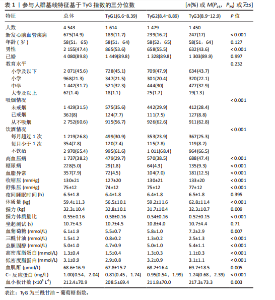
2.1 基线特征描述 4 543例无心脑血管疾病史的参与者在7年随访期间,有675例新发生了心脑血管疾病,发病率为14.9%。在TyG指数的第三分位水平发病率为17%,而在TyG指数第一分位水平时发病率为11.7%。如表1所示,根据TyG指数的三分位数描述了参与人群的基线特征,总体年龄四分位数为58岁(51岁,65岁),3组之间年龄差异无显著性意义(P > 0.05)。在TyG指数较高水平的人群中,女性的比例也相对较高,且随着TyG指数水平升高,体质量水平也增高,高血压、糖尿病和血脂异常的患病率也随之增加,而握力体质量比则降低。3组之间坐起测试时间相比差异无显著性意义(P > 0.05)。3组在性别、高血压史、糖尿病史、血脂异常史、吸烟状况、饮酒状况、收缩压、舒张压、体质量、握力、握力体质量比、三酰甘油、血葡萄糖、TyG指数、总胆固醇、高密度脂蛋白、低密度脂蛋白、血小板计数、血肌酐、C-反应蛋白等方面差异均有显著性意义(P < 0.05)。详见表1。 2.2 与新发心脑血管疾病的风险相关分析 使用COX比例风险回归分析TyG指数、握力体质量比(分类变量)、握力(分类变量)、坐起测试(分类变量)与新发心脑血管疾病之间的风险关系。 2.2.1 单因素分析 如表2 所示,新发心脑血管疾病的人群中,可能肌少症的患病率为40.6%,而未发生心脑血管疾病的人群中患病率为32.9%,单因素分析显示可能肌少症与新发心脑血管疾病呈显著正相关(风险比HR=1.364,P < 0.001),存在可能肌少症的人群新患心脑血管疾病的风险是对照人群的1.364倍,此外新发心脑血管疾病的参与者中坐起测试≥12 s的人群占36%,而对照组中为27.3%,差异有显著性意义(HR=1.458,P < 0.001)。但握力降低的比例在两组之间无明显差异,分别为12.3%和11%,COX回归分析结果不显著(HR=1.125,P=0.313)。握力体质量比与新发心脑血管疾病显著相关(HR= 1.476,P < 0.001),握力体质量比< 0.5的人群新发心脑血管疾病的风险是握力体质量比≥0.5的1.476倍。TyG指数也与新发心脑血管疾病风险显著正相关(HR=1.315,P < 0.001)。 2.2.2 多因素分析 调整了协变量的COX回归模型中也未观察到握力与新发心脑血管疾病之间的显著性关系,而调整协变量后可能肌少症、坐起测试、握力体质量比和TyG指数仍与新发心脑血管疾病风险显著相关。在调整了所有协变量的Model3中,可能肌少症(HR=1.22,P=0.02)、坐起测试(HR=1.302,P=0.002)、握力体质量比(HR=1.288,P=0.004)与新发心脑血管疾病均有显著相关性,握力体质量比< 0.5的人群新发心脑血管疾病的风险较对照组增高1.288倍。结果见表3。 2.3 非线性关系分析 进一步分析握"
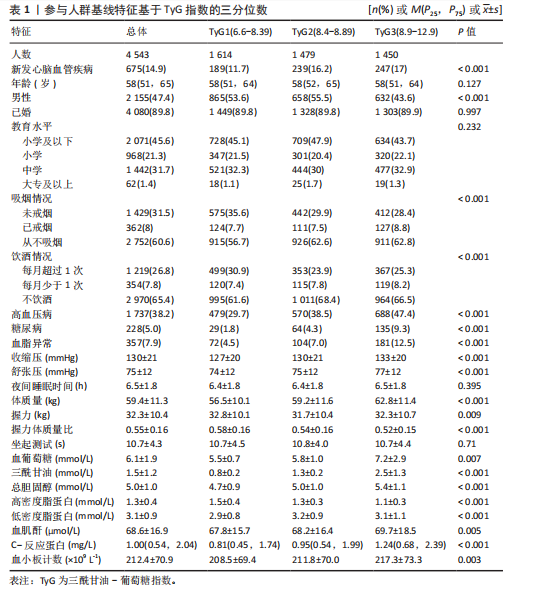
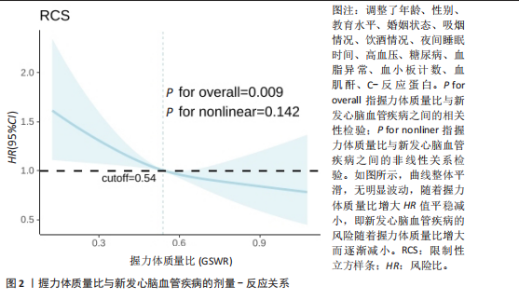
力体质量比与新发心脑血管疾病风险之间是否存在非线性关系,采用限制性立方样条绘制曲线,节点数设置为3,使用调整了所有协变量的Model3进行分析。参考过去类似研究,限制性立方样条分析多推荐3-5个节点,根据最小信息准则(akaike information criterion,AIC)[24],宜选择AIC值较小时的节点,此次研究分别计算了3,4,5个节点时的模型AIC值,其中节点数为3时AIC值最小。限制性立方样条分析曲线如图2所示,握力体质量比与新发心脑血管疾病之间未观察到非线性关系(P for nonliner=0.142)。 2.4 亚组分析 按性别、年龄、高血压、糖尿病、血脂异常、TyG指数、可能肌少症、坐起测试、握力进行分层,探讨了握力体质量比与新发心脑血管疾病风险之间的关系。年龄以60岁节点转化为二分类变量,TyG指数以中位数(8.6)为节点转化为二分类变量。结果见图3。 2.5 TyG指数的中介效应分析 在上述的单因素和多因素分析中均观察到了握力体质量比、可能肌少症、坐起测试、TyG指数与新发心脑血管疾病风险显著相关,进一步探索TyG指数在其中是否存在介导作用。以TyG指数为中介变量(M),是否新发心脑血管疾病为因变量(Y),分别以握力体质量比、疑似肌少症、坐起测试为自变量(X)进行中介效应检验,中介关系示意图见图4。此次模型中因变量为二分类变量,进行COX回归分析路径b、b’和c,而中介变量为连续变量,进行线性回归检验路径a。COX回归分析的中介模型可以使用R中的“CMAverse”包的“cmest”函数进行中介效应检验[23],采用Bootstrap法随机重复抽样,计算出总效应、总自然直接效应、总自然间接效应。中介效应检验结果见表4,握力体质量比的自然总效应为HR=1.29,95%CI:1.08-1.54,纳入中介变量后,握力体质量比对结局变量自然直接效应为HR=1.26,95%CI:1.05-1.50,总自然间接效应为HR=1.024,95%CI:1.005-1.043,中介效应和总效应结"
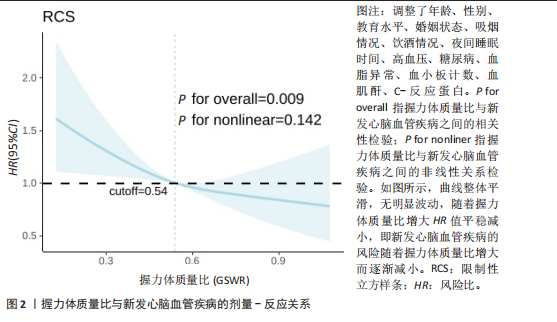
| [1] ROTH GA, MENSAH GA, JOHNSON CO, et al. Global Burden of Cardiovascular Diseases and Risk Factors, 1990-2019: Update From the GBD 2019 Study. J Am Coll Cardiol. 2020;76(25):2982-3021. [2] VIRANI SS, ALONSO A, APARICIO HJ, et al. Heart Disease and Stroke Statistics-2021 Update: A Report From the American Heart Association. Circulation. 2021;143(8): e254-e743. [3] DISEASES NCFC, HEALTH TWCOTROC, CHINA DI. 中国心血管健康与疾病报告2023概要[J]. 中国循环杂志,2024,39(7):625-660. [4] LI G, LU Y, SHAO L, et al. Handgrip strength is associated with risks of new-onset stroke and heart disease: results from 3 prospective cohorts. BMC Geriatr. 2023;23(1):268. [5] GAO K, CAO LF, MA WZ, et al. Association between sarcopenia and cardiovascular disease among middle-aged and older adults: Findings from the China health and retirement longitudinal study. EClinicalMedicine. 2022;44:101264. [6] DAMLUJI AA, ALFARAIDHY M, ALHAJRI N, et al. Sarcopenia and Cardiovascular Diseases. Circulation. 2023;147(20):1534-1553. [7] 王茜婷, 刘梅林. 老年冠心病患者合并肌肉减少症的相关性研究 [J]. 临床心血管病杂志,2018,34(12):1182-1186. [8] ZAMBONI M, MAZZALI G, FANTIN F, et al. Sarcopenic obesity: a new category of obesity in the elderly. Nutr Metab Cardiovasc Dis. 2008;18(5):388-395. [9] HAIDAR S, MAHBOUB N, PAPANDREOU D, et al. Triglyceride and Glucose Index as an Optimal Predictor of Metabolic Syndrome in Lebanese Adults. Nutrients. 2024;16(21): 3718. [10] 王馨, 周好奇, 胡真, 等. 职业人群中甘油三脂-葡萄糖指数与动脉粥样硬化的关系[J]. 中国心血管病研究,2024,22(11): 1007-1012. [11] SAWAF B, SWED S, ALIBRAHIM H, et al. Triglyceride-Glucose Index as Predictor for Hypertension, CHD and STROKE Risk among Non-Diabetic Patients: A NHANES Cross-Sectional Study 2001-2020. J Epidemiol Glob Health. 2024;14(3):1152-1166. [12] SÁNCHEZ-ÍÑIGO L, NAVARRO-GONZÁLEZ D, FERNÁNDEZ-MONTERO A, et al. The TyG index may predict the development of cardiovascular events. Eur J Clin Invest. 2016;46(2):189-197. [13] FAHED G, AOUN L, BOU ZERDAN M, et al. Metabolic Syndrome: Updates on Pathophysiology and Management in 2021. Int J Mol Sci. 2022;23(2):786. [14] SOUSA AC, ZUNZUNEGUI MV, LI A, et al. Association between C-reactive protein and physical performance in older populations: results from the International Mobility in Aging Study (IMIAS). Age Ageing. 2016; 45(2):274-280. [15] FERRUCCI L, PENNINX BW, VOLPATO S, et al. Change in muscle strength explains accelerated decline of physical function in older women with high interleukin-6 serum levels. J Am Geriatr Soc. 2002;50(12):1947-1954. [16] YOO JI, KIM MJ, NA JB, et al. Relationship between endothelial function and skeletal muscle strength in community dwelling elderly women. J Cachexia Sarcopenia Muscle. 2018;9(6):1034-1041. [17] STUMP CS, HENRIKSEN EJ, WEI Y, et al. The metabolic syndrome: role of skeletal muscle metabolism. Ann Med. 2006;38(6): 389-402. [18] KOSMAS CE, BOUSVAROU MD, KOSTARA CE, et al. Insulin resistance and cardiovascular disease. J Int Med Res. 2023;51(3): 3000605231164548. [19] HILL MA, YANG Y, ZHANG L, et al. Insulin resistance, cardiovascular stiffening and cardiovascular disease. Metabolism. 2021; 119:154766. [20] HOLTEN MK, ZACHO M, GASTER M, et al. Strength training increases insulin-mediated glucose uptake, GLUT4 content, and insulin signaling in skeletal muscle in patients with type 2 diabetes. Diabetes. 2004;53(2):294-305. [21] ZHAO Y, HU Y, SMITH JP, et al. Cohort profile: the China Health and Retirement Longitudinal Study (CHARLS). Int J Epidemiol. 2014;43(1):61-68. [22] MACKINNON DP, FAIRCHILD AJ, FRITZ MS. Mediation analysis. Annu Rev Psychol. 2007;58:593-614. [23] SHI B, CHOIRAT C, COULL BA, et al. CMAverse: A Suite of Functions for Reproducible Causal Mediation Analyses. Epidemiology. 2021;32(5):e20-e22. [24] LIU Z, SONG C, SUO C, et al. Alcohol consumption and hepatocellular carcinoma: novel insights from a prospective cohort study and nonlinear Mendelian randomization analysis. BMC Med. 2022; 20(1):413. [25] CHEN LK, WOO J, ASSANTACHAI P, et al. Asian Working Group for Sarcopenia: 2019 Consensus Update on Sarcopenia Diagnosis and Treatment. J Am Med Dir Assoc. 2020; 21(3):300-307.e302. [26] LEE J, HONG YP, SHIN HJ, et al. Associations of Sarcopenia and Sarcopenic Obesity With Metabolic Syndrome Considering Both Muscle Mass and Muscle Strength. J Prev Med Public Health. 2016;49(1):35-44. [27] CRUZ-JENTOFT AJ, SAYER AA. Sarcopenia. Lancet. 2019;393(10191): 2636-2646. [28] HAMASAKI H, KAWASHIMA Y, ADACHI H, et al. Associations between lower extremity muscle mass and metabolic parameters related to obesity in Japanese obese patients with type 2 diabetes. PeerJ. 2015; 3:e942. [29] KARLSEN T, NAUMAN J, DALEN H, et al. The Combined Association of Skeletal Muscle Strength and Physical Activity on Mortality in Older Women: The HUNT2 Study. Mayo Clin Proc. 2017;92(5):710-718. [30] ZHANG K, LI X, GUO Q, et al. Lower extremity function and cardiovascular disease risk in hemodialysis patients: A multicenter cross-sectional study. Physiol Rep. 2024;12(16):e70014. [31] FENG S, WANG J, YIN C, et al. The association between lower extremity function and cardiovascular diseases risk in older Chinese adults: Longitudinal evidence from a nationwide cohort. Arch Gerontol Geriatr. 2024;124:105463. [32] CAMPO G, MAIETTI E, TONET E, et al. The Assessment of Scales of Frailty and Physical Performance Improves Prediction of Major Adverse Cardiac Events in Older Adults with Acute Coronary Syndrome. J Gerontol A Biol Sci Med Sci. 2020;75(6):1113-1119. [33] KUENZE C, PIETROSIMONE B, CURRIE KD, et al. Joint Injury, Osteoarthritis, and Cardiovascular Disease Risk Factors in Former National Football League Athletes: An NFL-LONG Study. J Athl Train. 2023;58(6): 528-535. [34] 殷明越, 刘骞, 许雄壮, 等. 久坐间断对成年人血管功能的急性影响与调节因素:荟萃分析 [J]. 中国组织工程研究,2025, 29(17):3684-3696. [35] ALCAZAR J, LOSA-REYNA J, RODRIGUEZ-LOPEZ C, et al. The sit-to-stand muscle power test: An easy, inexpensive and portable procedure to assess muscle power in older people. Exp Gerontol. 2018;112: 38-43. [36] FACCIORUSSO S, GUANZIROLI E, BRAMBILLA C, et al. Muscle synergies in upper limb stroke rehabilitation: a scoping review. Eur J Phys Rehabil Med. 2024;60(5):767-792. [37] BARZEGAR N, TOHIDI M, HASHEMINIA M, et al. The impact of triglyceride-glucose index on incident cardiovascular events during 16 years of follow-up: Tehran Lipid and Glucose Study. Cardiovasc Diabetol. 2020;19(1):155. [38] ARAÚJO SP, JUVANHOL LL, BRESSAN J, et al. Triglyceride glucose index: A new biomarker in predicting cardiovascular risk. Prev Med Rep. 2022;29:101941. [39] FRANKLIN BA, EIJSVOGELS TMH, PANDEY A, et al. Physical activity, cardiorespiratory fitness, and cardiovascular health: A clinical practice statement of the American Society for Preventive Cardiology Part II: Physical activity, cardiorespiratory fitness, minimum and goal intensities for exercise training, prescriptive methods, and special patient populations. Am J Prev Cardiol. 2022;12: 100425. |
| [1] | Zhou Jian, Zhang Tao, Zhou Weili, Zhao Xingcheng, Wang Jun, Shen Jie, Qian Li, Lu Ming. Effects of resistance training on quadriceps mass and knee joint function in patients with osteoporosis and sarcopenia [J]. Chinese Journal of Tissue Engineering Research, 2026, 30(5): 1081-1088. |
| [2] | Li Hanyue, Li Yini, Xiang Linmei, Li Sen. Effects of resistance exercise therapy on pain and function in patients with cervical spondylotic radiculopathy: a meta-analysis [J]. Chinese Journal of Tissue Engineering Research, 2026, 30(4): 987-996. |
| [3] | Sun Jiahe, Shi Jipeng, Zhu Tianrui, Quan Helong, Xu Hongqi. Effect of exercise intervention in elderly individuals with sarcopenia and its comorbidities: a meta-analysis [J]. Chinese Journal of Tissue Engineering Research, 2026, 30(4): 997-1007. |
| [4] | Wang Peng, Lu Huan, Liu Haifeng, Li Feng. Mechanism by which andrographolide intervenes in insulin resistance in rats with gestational diabetes mellitus [J]. Chinese Journal of Tissue Engineering Research, 2026, 30(12): 3058-3065. |
| [5] | Li Tingwen, , Zhang Jianhua. Meta-analysis of the effects of aquatic exercise on balance function and motor ability in elderly patients with Parkinson’s disease [J]. Chinese Journal of Tissue Engineering Research, 2026, 30(10): 2560-2568. |
| [6] | Zhang Zixian, Xu Youliang, Wu Shaokui, Wang Xiangying. Effects of blood flow restriction training combined with resistance training on muscle indicators in college athletes: a meta-analysis [J]. Chinese Journal of Tissue Engineering Research, 2025, 29(8): 1705-1713. |
| [7] | Wang Juan, Wang Guanglan, Zuo Huiwu. Efficacy of exercise therapy in the treatment of anterior cruciate ligament reconstruction patients: #br# a network meta-analysis #br# [J]. Chinese Journal of Tissue Engineering Research, 2025, 29(8): 1714-1726. |
| [8] | Cai Zhixing, Xia Qiufang, Chen Lili, Zhu Danyang, Zhu Huiwen, Sun Yanan, Liang Wenyu, Zhao Heqian. Effect of Roujishuncuiyin on the improvement of skeletal muscle insulin resistance in a mouse model of type 2 diabetes mellitus [J]. Chinese Journal of Tissue Engineering Research, 2025, 29(35): 7537-7543. |
| [9] | Liu Xuan, Ding Yuqing, Xia Ruohan, Wang Xianwang, Hu Shujuan. Exercise prevention and treatment of insulin resistance: role and molecular mechanism of Keap1/nuclear factor erythroid2-related factor 2 signaling pathway [J]. Chinese Journal of Tissue Engineering Research, 2025, 29(35): 7578-7588. |
| [10] | Jiang Siqi, Huang Huanhuan, Yu Xinyu, Peng Ying, Zhou Wei, Zhao Qinghua. Meta-analysis of dose-effect of exercise on improving muscle health in community-dwelling older adults with sarcopenia [J]. Chinese Journal of Tissue Engineering Research, 2025, 29(29): 6295-6304. |
| [11] | Ding Yuan, Gong Jianbao, Zhang Jie, Qiao Yuan, Xu Wenlong. Characteristic analysis of isometric muscle strength of knee joint in patients after unicompartmental knee arthroplasty [J]. Chinese Journal of Tissue Engineering Research, 2025, 29(27): 5833-5838. |
| [12] | Wang Xia, Xue Boshi, Yang Chen, Zhou Zhipeng, Zheng Liangliang. Influence of neuromuscular function on the risk of biomechanical injury in landing manoeuvres in patients undergoing anterior cruciate ligament reconstruction [J]. Chinese Journal of Tissue Engineering Research, 2025, 29(26): 5556-5562. |
| [13] | Zhu Tianrui, Shi Jipeng, Sun Jiahe, Wang Luyi, Zhang Chen, Xu Hongqi, Quan Helong. Effectiveness of different exercise regimens to reduce fall risks in older adults: a Meta-analysis [J]. Chinese Journal of Tissue Engineering Research, 2025, 29(26): 5662-5672. |
| [14] | Chen Jinjie, Li Geng, Jiang Yefan. Role of Siblings protein family in cardiovascular diseases [J]. Chinese Journal of Tissue Engineering Research, 2025, 29(24): 5171-5178. |
| [15] | Chen Chunlan, Ye Meiyi, Pan Yuwei, Yuan Jia, Zhou Pengjun. Immunomodulatory effect of umbilical cord mesenchymal stem cells on type 2 diabetes mellitus [J]. Chinese Journal of Tissue Engineering Research, 2025, 29(23): 5031-5040. |
| Viewed | ||||||
|
Full text |
|
|||||
|
Abstract |
|
|||||
